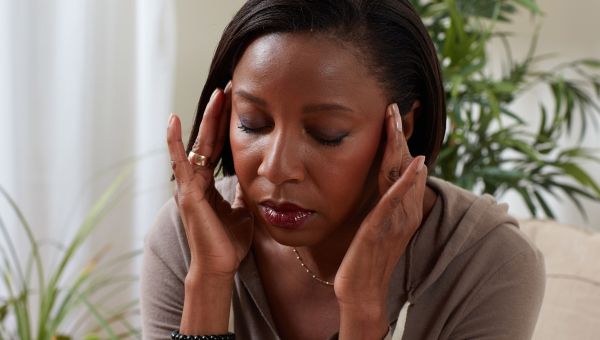Is it PMS or something else?
Painful cramps, bouts of irritability or sadness, sleep issues—sometimes it's more than PMS.
Updated on April 19, 2024

Are intense emotions and physical symptoms affecting your day-to-day life when you have your period?
Premenstrual syndrome (PMS) could be the cause. But in many cases, there's an underlying health condition that may be at play. Here’s what you need to know.

First, what exactly is PMS?
PMS is a group of symptoms that people tend to experience around the time of their menstural period. It usually starts a few days before menstruation.
"The symptoms are categorized as emotional or physical, but many people have both," explains Christopher Manipula, MD, an OBGYN in Chester, Virginia.
Emotional symptoms include irritability, crying spells, and anxiety. Physical symptoms may include:
- Breast tenderness
- Bloating
- Headaches
- Gastrointestinal issues
- Dizziness
One of the big challenges with PMS is that symptoms are often vague and generalized, says Dr. Manipula. That can make it difficult to tell it apart from other conditions. With that in mind, here are six health issues that are often mistaken for PMS.

Depression
"Depression and anxiety disorders are the most common conditions that overlap with PMS," says Manipula. "In fact, about a half of all people who seek treatment for PMS have one of these two disorders." Symptoms that could indicate depression include:
- Loss of interest in the activities you once enjoyed
- Feelings of hopelessness
- Weight gain or loss
- Sleeping too much or too little
- Trouble concentrating
How can you tell whether it’s depression or PMS? With PMS, the symptoms tend to ease up about four or five days after your period is over. "With depression or anxiety, the symptoms are present all month long," Manipula explains. They may also worsen around the time of your period.

The transition to menopause
The average age that people begin menopause is 51. But the transition to menopause, called perimenopause, can start years before that. Many people experience irregular periods during perimenopause.
Perimenopause symptoms are similar to PMS and may overlap. Because ovulation can still occur during perimenopause, it is still possible to become pregnant if you have sex without birth control.
"Once your cycle stops for over a full year, you’ve likely completed the transition," says Manipula. Menopause symptoms can include sleep disturbances, depressed mood, low libido, and foggy thinking. It can help to work with a healthcare provider (HCP) to treat any symptoms that may be affecting your quality of life and, if you are sexually active, to find birth control that’s right for you.

Endometriosis
Endometriosis may affect approximately 5 million women in the United States. Many researchers believe the actual number is higher, however, since the condition is often ignored or mistaken as PMS.
"Many of the symptoms are the same, like bloating, pain, and cramping," says Manipula. "I think that’s why people—even healthcare providers—sometimes overlook endometriosis."
Endometriosis involves the growth of the tissue that lines the uterus (or endometrium) outside of your uterus, usually on other organs in your abdomen. The tissue bleeds each month with your period. Endometriosis can cause severe pain, including pain during sex, urination, or bowel movements. If you have very painful periods, your symptoms may not be typical. Ask your HCP if endometriosis could be the cause.

Ovarian Cancer
Ovarian cancer may be highly treatable when found early, but the American Cancer Society predicts that 12,740 women will die of ovarian cancer in 2024. That’s because ovarian cancer is often diagnosed at later stages, when it is often more difficult to treat. Symptoms can be vague and mistaken for PMS or another health condition. These symptoms can include:
- Abdominal or pelvic pain
- Bloating
- Feeling full quickly after eating
- Frequent or urgent urination
"The challenges with ovarian cancer are that there’s no screening test for it and the symptoms are so vague that it’s easily dismissed," says Manipula. "By the time symptoms worsen, and someone goes to their doctor, it’s often advanced." If your symptoms last longer than two weeks, occur frequently, aren’t consistent with your typical periods, or you have any other concerns, contact an HCP.

Premenstrual Dysphoric Disorder (PMDD)
"PMDD, or premenstrual dysphoric disorder, is a severe form of PMS," says Manipula. "It’s diagnosed when someone has at least five symptoms, such as frequent crying, anger that leads to conflict, a lack of interest in favorite activities, appetite changes, headaches, muscle pain, bloating, and others."
To help make a diagnosis, your HCP might ask you to keep a journal for one to three months to learn more about your symptoms. The journal may include:
- What you were doing before and after each symptom started
- Your exercise and eating habits
- Your sleep schedule
- Any medications, teas, or supplements you take
PMDD treatments include hormone therapies, antidepressants, and talk therapy. Sometimes, PMDD can lead to thoughts of suicide or hurting yourself. If you are having thoughts of suicide, go to an emergency room right away, reach out to your HCP, or call, text, or chat 988 to the 988 Suicide & Crisis Lifeline.

Dysmenorrhea
The terms PMS and dysmenorrhea are often used interchangeably, but they are not the same thing. Dysmenorrhea refers to especially painful periods, usually involving cramps in the lower back and abdomen. Cramping typically lasts for 12 to 72 hours around the start of menstruation.
Pain may be caused by your period itself, called primary dysmenorrhea. In this case, your HCP may prescribe pain-relief medication or birth control pills. You can help minimize your period pain by:
- Taking ibuprofen as soon as your pain starts
- Placing a heating pad over the painful area
- Avoiding caffeine, nicotine, and alcohol
- Exercising
- Getting sufficient sleep (seven to nine hours nightly, on average, for healthy adults)
- Reducing stress
Your pain may also be caused by another condition, such as endometriosis or fibroids. This is called secondary dysmenorrhea, and requires treatment of the underlying health condition.

When to get help for PMS
If PMS is affecting your job performance, your relationships, or your daily life, make an appointment with an HCP. Not sure if you’re experiencing PMS or something else?
"My philosophy with all of my patients is if you're concerned about anything, just come see me," says Manipula. "If something is on your mind, give your doctor a call because we’re worried about whatever is worrying you."

Cleveland Clinic. Dysmenorrhea. July 13, 2014.
National Institute on Aging. What Is Menopause? June 27, 2017.
American Cancer Society. Key Statistics for Ovarian Cancer. January 8, 2020.
InformedHealth.org. Premenstrual syndrome: Overview. June 15, 2017.
UpToDate.com. Treatment of premenstrual syndrome and premenstrual dysphoric disorder. October 2020.
F Shobeiri, FE Araste, et al. Effect of calcium on premenstrual syndrome: A double-blind randomized clinical trial. Obstetrics & Gynecology Science. 2017 Jan;60(1):100-105.
Merck Manual Consumer Version. Premenstrual Syndrome (PMS). July 2019.
American College of Obstetricians and Gynecologists. Premenstrual Syndrome (PMS). May 2015.
Mayo Clinic. Menopause. October 14, 2020.
WomensHealth.gov. Endometriosis: A Fact Sheet From the Office on Women’s Health. August 18, 2014.
Sona Pharmacy + Clinic. Is it PMS or Perimenopause? Accessed December 7, 2020.
American Cancer Society. Signs and Symptoms of Ovarian Cancer. April 11, 2018.
WomensHealth.gov. Premenstrual dysphoric disorder (PMDD). March 16, 2018.
Cleveland Clinic. Premenstrual Dysphoric Disorder (PMDD). November 23, 2020.
American College of Obstetricians and Gynecologists. Dysmenorrhea: Painful Periods. June 2020.
Cleveland Clinic. Dysmenorrhea: Management and Treatment. November 20, 2020.
More On


video

article

slideshow


video


video
